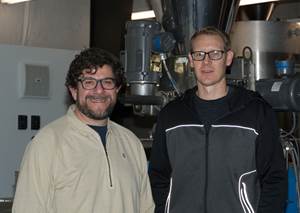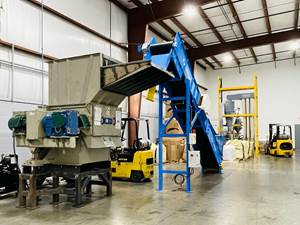New Plasticizer Chemistry for PVC Excels in Cold & Heat
It’s rare that an entirely new plasticizer chemistry comes along for flexible PVC—especially when it comes with an established health and safety record.
It’s rare that an entirely new plasticizer chemistry comes along for flexible PVC—especially when it comes with an established health and safety record. New Flexidone plasticizers also promise unprecedented high efficiency, extreme low-temperature performance, very low volatility at elevated temperatures, and time and energy savings in processing due to fast gelation at low temperatures.
Flexidone plasticizers from International Specialty Products Inc. (ISP), Wayne, N.J. (ispplastics.com), are based on N-aklyl pyrrolidone chemistry. They are based on about 70% renewable raw materials (fatty amines). According to Hasan Kaytan, ISP new-´óĎó´«Ă˝ development manager, alkyl pyrrolidones were found to plasticize PVC 20 years ago, but this application was not pursued until recently. In the meantime, alkyl pyrrolidones have been used in shampoos, dishwasher detergents, and other cleaners. They have recently been tested in PVC—especially plastisols—by German vinyl resin maker Vestolit and at the University of Cologne.
Four products are commercially available, with chain lengths from C8 to C18. Short to mid-length chains provide high solvating and flexibilizing efficiency, while longer chains lend superior stability and durability to products that must hold up in hot conditions.
ISP recommends Flexidone products for general-purpose use. However, these are premium specialty products costing two to two-and-a-half times as much as standard phthalates. So Flexidone will be used mainly in combination with other plasticizers. Kaytan says Flexidone is compatible with all other plasticizers and ingredients used in flexible PVC. In fact, Flexidone reportedly increases the compatibility of other formulation ingredients—allowing, for example, high levels of inexpensive secondary plasticizers such as chlorinated paraffins or fatty (palmitic, oleic) esters. Flexidone also helps comptibilize high filler loads and can allow increases in filler levels, says Kaytan. In addition, Flexidone products have around 10% lower specific gravity than phthalates, which partially compensates for their higher cost/lb. In fact, ISP claims that total formulation cost with Flexidone is equal to or lower than that with other plasticizers.
As shown in the accompanying graph, Flexidone 300 and 500 (medium and long-chain) provide better low-temperature flexibility than conventional low-temperature plasticizers such as adipates (DOA). They can provide flexibility down to -70 C (-94 F). Long-chain Flexidone 500 reportedly also provides very low volatility at elevated temperature, comparable to DINP. Water and oil extractability are said to be comparable to phthalates.
Workhorse Flexidone 300 (short-chain) is “by far the most efficient plasticizer in the world,” claims Kaytan, “30% to 40% more efficient than standard phthalates, thus allowing lower use levels.”
He also emphasizes the processing advantages of Flexidone plasticizers, because they are absorbed more quickly and at lower temperatures than many other plasticizers, especially longer-chain phthalates that are being substituted for DOP. In plastisols or dryblends, replacing 15% to 30% of other plasticizers with Flexidone will reduce mix times and temperatures and also provide significant improvements in transparency of clear vinyls, Kaytan says.
Flexidone has been used for more than two years in extruded PVC pencil erasers. Other applications being considered in Europe and Turkey are automotive door seals and thick sheets used in cold warehouses. Plastisols with Flexidone are being developed for disposable gloves and carpet backing. Kaytan notes that ISP has not sought food-contact or medical approvals for Flexidone.
Related Content
More Than a Compounder: They Have the Science to Create New Custom Materials
Insight Polymers & Compounders leverages its expertise in polymer chemistry to develop next-generation materials.
Read MoreEngineering Resins Compounder Expands to Take on More Scrap
Polymer Resources responds to sustainability push by upgrading plant with grinding and shredding equipment to take on both postindustrial and postconsumer reclaim.
Read MoreA Purge Solution for the Blow Molding and Compounding Industries
New commercial purge compounds for new industries from Chem-Trend.
Read MoreHow to Configure Your Twin-Screw Extruder: Part 3
The melting mechanism in a twin-screw extruder is quite different from that of a single screw. Design of the melting section affects how the material is melted, as well as melt temperature and quality.
Read MoreRead Next
For PLASTICS' CEO Seaholm, NPE to Shine Light on Sustainability Successes
With advocacy, communication and sustainability as three main pillars, Seaholm leads a trade association to NPE that ‘is more active today than we have ever been.’
Read MoreBeyond Prototypes: 8 Ways the Plastics Industry Is Using 3D Printing
Plastics processors are finding applications for 3D printing around the plant and across the supply chain. Here are 8 examples to look for at NPE2024.
Read More










